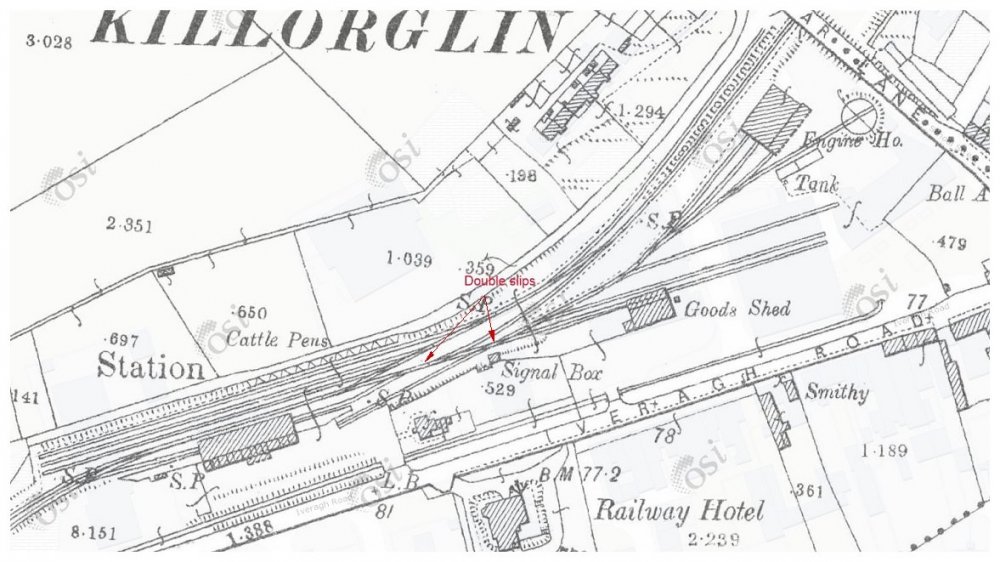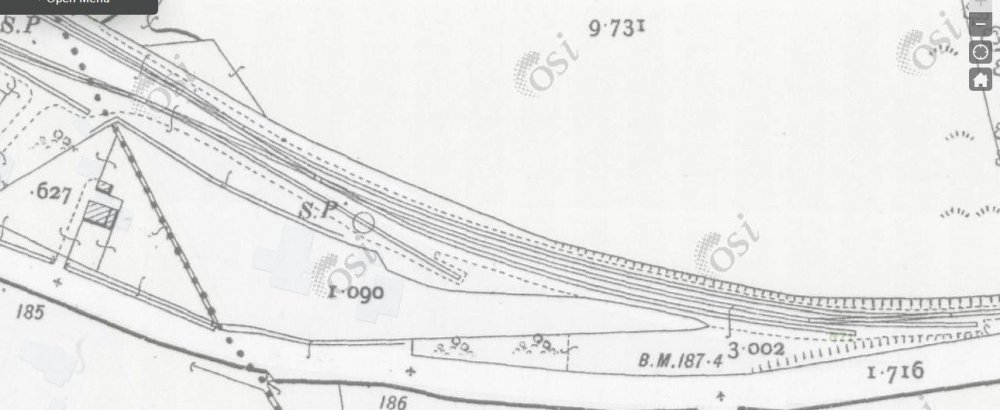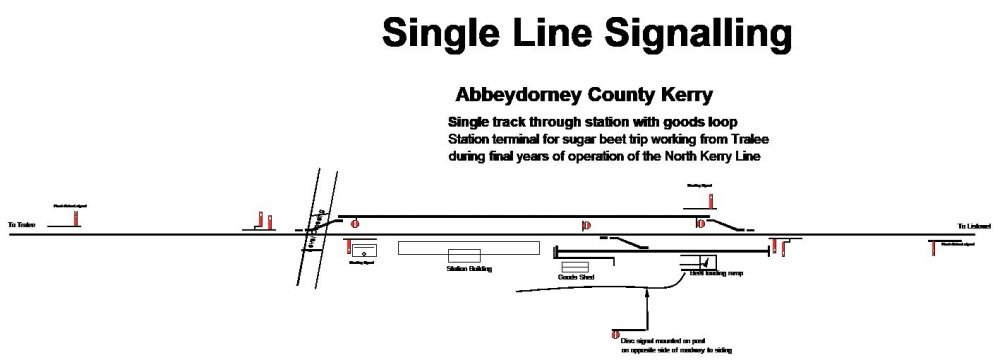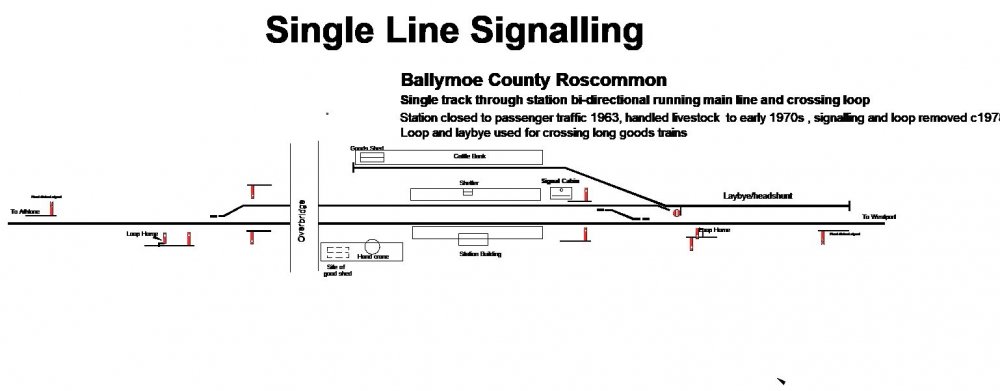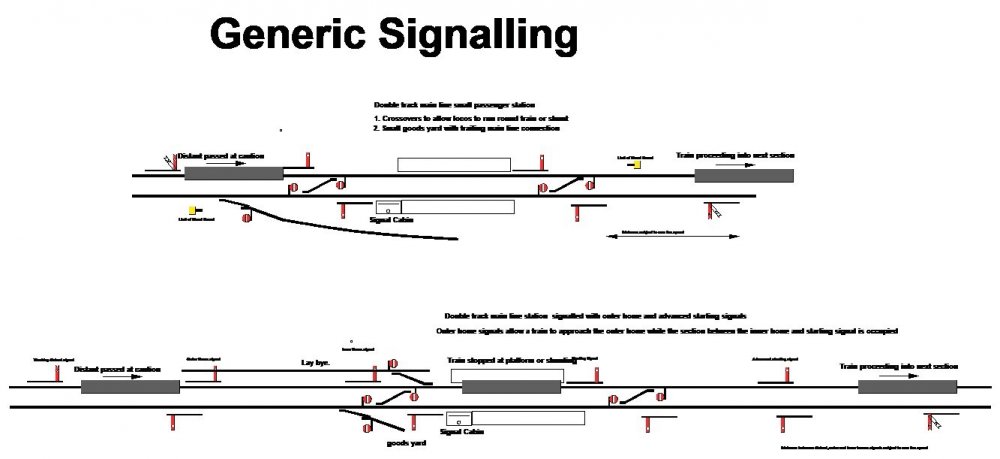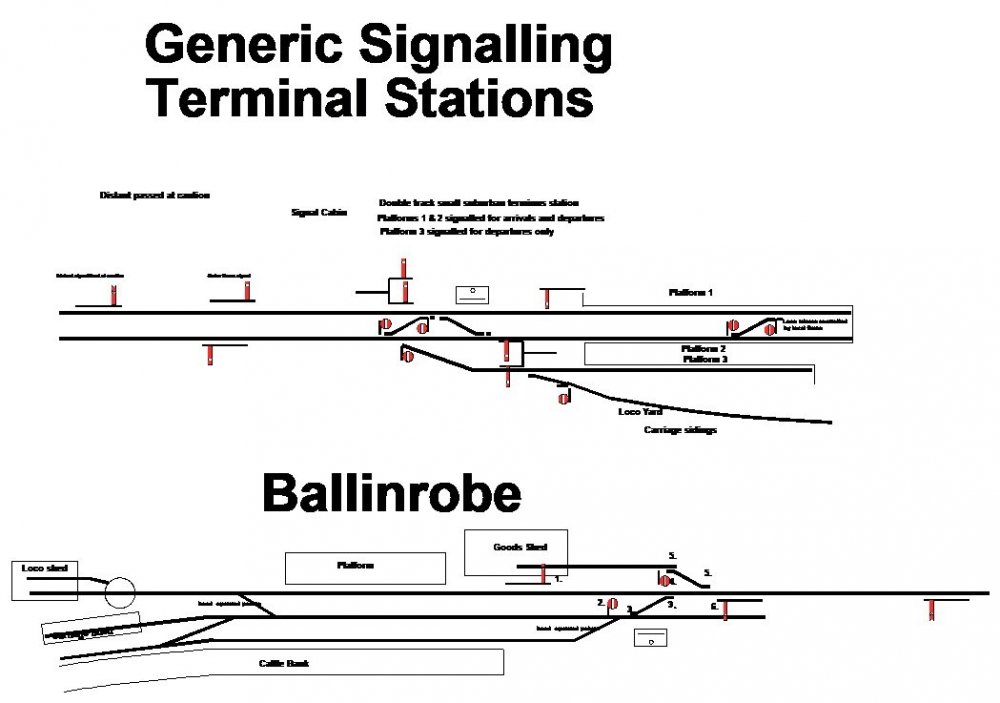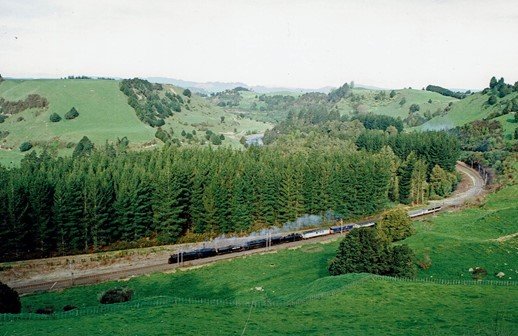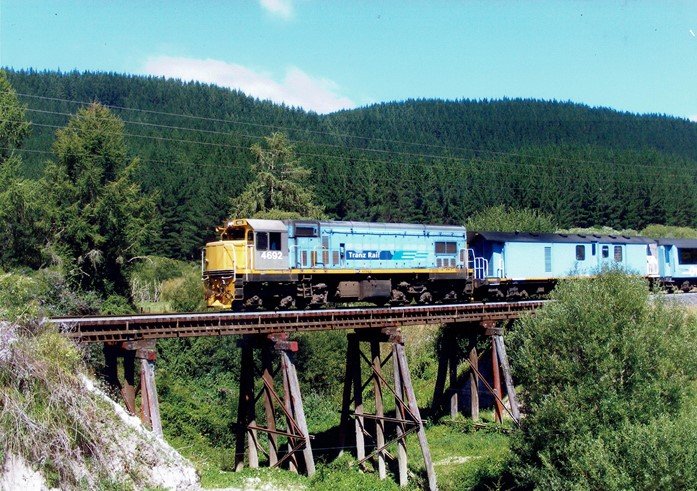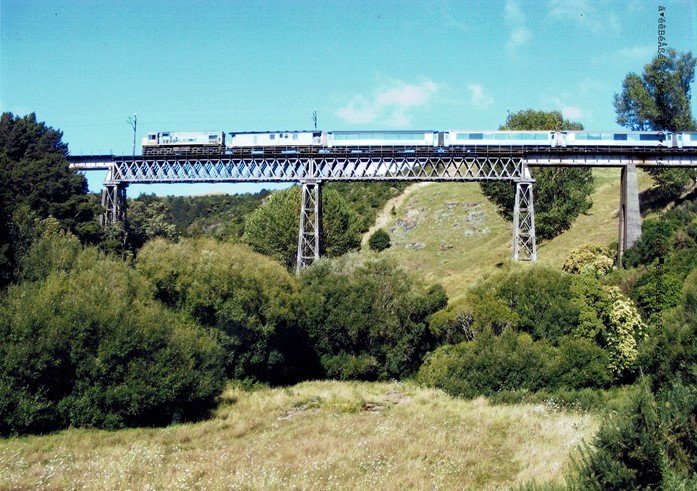-
Posts
4,871 -
Joined
-
Last visited
-
Days Won
119
Content Type
Profiles
Forums
Events
Gallery
Blogs
Store
Community Map
Everything posted by Mayner
-
Killorglin was a good example of the use of double slips in a GSWR branch line context with two double slips on the crossover from the main running line to the goods yard. Paul Greene's Kilbrandon Layout is based on Killorglin. http://killorglinarchives.com/killorglin-railway-station-1958/ Killorglin was originally the terminus of the line from Farranfore before the branch was extended to Valencia, the station had a fairly impressive overall roof similar to Tullow with wooden rather than masonry station building, stations on both the GSWR Valencia Harbour extension and Kenmare branches were to a standard corrugated iron design, though the WLWR used a standard rendered masonry design of station building on the line north from Tuam to Collonney Junction built during the same era as a "Balfour Line" to Belmullet.
-
Murphy Models may have 141 spares, Paddy supplied a set of replacement handrails on request a couple of years ago.
-
It would be interesting to see more modelers adapting/developing the "ONe-TRAK" modular system developed in the States during the 1990s. One-TRAK modular layouts tended be more realistic in appearance (scenery and structures) than traditional N TRAK or T Trak modular layouts. The 15" and One-Track-Minds groups applied similar principals in OO & S scale modelling, with group members building modules that could be incorporated into a larger layout at a group meeting or exhibition. http://www.ntrak.org/documents/oNeTRAK_Manual.pdf
-
A bit more progress with the Y Boiler 650 Class following an amendment to the design of the smokebox-wrapper. Unfortunately the engravers managed to add an error or two to my own in updating the photo tool delaying release of this particular variation of the class. The dome and chimney were just plonked on the loco and require further fettling and adjustment before final fixing in position, some tweeking is required to the handrail at the firebox end. MGWR 1918-1934 superheated version for comparison. The GSR & CIE maintained both the Belpaire and Round topped 650 Class boilers in a common pool, with a number of spare boilers available to speed up the repair and overhaul process. GSR developed its own utilitarian style of loco detailing during the 1930s, quite distinct from the styling of the 1920s.
-
Back in the 70s a suspect bank robber tried to hide on a construction site while being pursued by the Gardai. Suspect runs into a house picks up a set of plasterers tools and starts plastering a wall, the plasterer and his mate had just left the house to have a break. Special Branch Officer then runs into the house and asks the "plasterer" if anyone had run into the house before recognising and arresting the suspect.
-
Most likely for exchanging goods traffic between the main line and the Branch, the loop looks a bit short for shunting a goods train clear of the main line, its possible the crossover at the Bandon end of the loop was operated by a ground frame at the points rather than from the signal box. The loop would have also been useful to allow sugar beet specials from Clonakilty and the Courtmacsharry branch to run through onto the main line without having to shunt at the station. The loop would have allowed East or Westbound goods trains to attach or detach wagons to and from the branch with the minimum of shunting movements.
-
The containers would have been supplied to CIE complete with forklift pockets. https://www.hapag-lloyd.com/content/dam/website/downloads/press_and_media/publications/15211_Container_Specification_engl_Gesamt_web.pdf. As far as I know all the 10' containers used for sundries traffic and some of the 20' CIE containers were manufactured with forklift pockets. Container pockets can be useful for moving containers around a factory, freight depot or container storage yard. The biggest drawback using forklift tines to load containers was that the gross container load was restricted to 7.5 tonne, at some yards including Tralee and Ballinasloe forklifts with lifting gear capable of lifting 25t containers 20-40 length were provided rather than a gantry.
- 97 replies
-
- 1
-

-
- weedspray
- 42 ft flat
-
(and 2 more)
Tagged with:
-
The "Boat Train" stock is available as sets of scratchbuilders parts (5 different types of coach) from Worsley Works in both 4 & 3mm scale. Alan Doherty might be persuaded to produce a set of parts for one of the locos, but its difficult to see anyone releasing a rtr model or a conventional kit for an NCC 2-4-2T or the coaches. It would be simple enough to build a static model of one of the locos in plasticard though the outside walschaerts valve gear would be challenging.
-
The lack of local buy in (financial & labour) is likely to be a bigger factor (plain lack of interest in heritage or railways) in the failure of railway preservation schemes in the Republic than low population density compared with the UK. There are many successful schemes in remote areas of the Australia, New Zealand and the United States which were established, funded and operated by local communities. The main exception being the restoration of the West Clare which appears to have been largely the vision of Jackie Whelan a local business man and the Cavan & Leitrim which has more in common with the smaller grass roots volunteer railways funded and operated largely by the membership with little or no professional business involvement. Perhaps there is a greater sense of ownership in communities which still have a strong sense of self sufficiency having settled the land and built their towns and railways, than in Ireland where the railways were associated more with British rule and the landed gentry than local enterprise. Local groups in the San Juan Mountains established museums and demonstration running lines in Ridgeway (pop 713) and Dolores (pop 936) to preserve artifacts of the Rio Grande Southern Narrow gauge. Local tourism in Ridgeway is heavily based on providing volunteer guides mainly active retired people who have retired to the mountains. In New Zealand population similar to Ireland much bigger land mass some preserved lines operate on a very occasional basis restoration of locos and stock is largely funded by the owners, in remote South Canterbury a number of local groups have recovered and restored steam locos that were dumped into rivers 80-90 years ago http://www.whitebusfamily.co.nz/first_restoration.htm. The situation appears to be much the same in Australia though there appears to be a bit more Federal Government/State largess than in New Zealand or Ireland with both Federal and Tasmania funding the restoration of the West Coast Wilderness Railway of the Abt Railway through one of the remotest parts of a remote State! https://www.wcwr.com.au/ This would be the equivalent of the EU & Merrion St funding the restoration of the Tralee & Dingle or Mountain-Stage to Cahirciveen and letting the operating contract to Belmond.
-
A C/B201 Class appears to be the most significant gap for a high quality rtr diesel loco within the late 50-late 80s time frame. A reasonably large class by Irish Standards a must for branch line and pilot duties in their original form, the re-engined locos were initially used on main line passenger and freight duties before taking over Dublin Suburban duties in the early 70s, but also appear to have been extensively used on Drogheda-Dublin bulk and bagged cement trains (Saturday afternoon spent working/trainspotting near Howth Junction in late 70s. The AEC railcar/CIE push pull set is an essential for the 50-70s period on CIE & the Great Northern, intermediate vehicles would be a challenge with CIE & GNR using different stock. A 4 car set with open 3rd and Buffet car in GNR Blue and Cream livery would be eye watering or a CIE set in the original light green. The main challenge would be designing accurate models of coaches as apart from the Buffet Cars most suitable GNR & CIE coaching stock has been scrapped, Park Royals and Laminates appeared several years after the CIE railcars entered service.
-
Another road-rail conversion a bitumen company used a Scammell tractor unit for shunting tank wagons on a private siding at Oranmore during the 60s & 70s, the tractor was fitted with a ballast bin to assist traction and braking. There is a photo of the tractor in Oranmore goods yard in "Rails through the West"
-
Living off immoral earnings or an undercover "sting" operation?
-
Ballymoe on the Mayo Line & Abbeydorney on the Limerick-Tralee line two examples of signalling of small stations on single track secondary main lines. The Mayo Line is more main line in character than the North Kerry with relatively heavy passenger and goods traffic between Dublin and the principal towns in Mayo & Roscommon, while traffic on the North Kerry was traditionally more local in nature through Dublin-Tralee goods and passenger traffic was mainly routed by Mallow and Killarney. Ballymoe was a small station and crossing place between Roscommon and Castlerea on the Athlone-Westport line, the station closed to passenger traffic along with other smaller stations on the Midland in 1963 but continued to handle cattle traffic into the early 1970s the signal cabin and loop closing following the introduction of Liner Train operation on the Mayo Line in the late 1970s. While the majority of passenger trains called at Ballymoe the Ballina Goods did not call at the smaller stations between Athlone and Manulla Junction and ran non-stop through Ballymoe, in Midland Days the prestigious Up and Down Limited Mail (Day mail) also ran non-stop through Ballymoe during the 1890s Signalling: 1. The track is aligned for non-stop running along the main platform road (Up Line) with both platform roads signaled for bi-directional or "Double Way" running, similar in principal to the Dublin-Galway main line, Rosslare Strand-Mallow and Ballymena-Derry on the NCC. 2. The distant or fishtail signals are fixed at caution as all trains are required to stop or slow to 35mph? for manual staff exchange. 3. The "Mother & Child" home signals are fitted with a second arm on a bracket at lower level (loop home) which controlled access to the passing loop 4. The height of signal posts & arms vary to assist drivers sighting signals. The down home signal at the Athone end of the station is on a tall post to assist drivers sighting from a distance, while the loop home is mounted at cab level, the up main and loop starting signals at the Athlone end of the station are on short posts to assist sighting through the road overbridge, the down loop starter is on a shorter post than the down main starting signal possibly to reduce the risk of a driver of a non stop train confusing the two signals. 5. A disc controls access from the headshunt to the loop. 6. Movements from the loop to the head shunt may have been controlled by flag signal rather than lowering the starter. It was usually necessary to obtain authorisation (The ETS) to enter the next section in order to lower a starting signal on a single line on the CIE system. 7. All signal posts appeared to be wooden of GSR origin. Mechanical staff exchange was not installed on the Mayo Line unlike the Galway, Mallow-Rosslare and NCC main line. The laybye/headshunt allows a signalman to set up a crossing with a goods train that is longer than the crossing loop or to shunt a goods train clear of the running lines to allow two passenger trains to cross. Abbeydorney was a small passing station with a single platform, small goods yard and loop for crossing goods trains on the Limerick to Tralee Line. Traffic was lighter than on the Mayo Line with one passenger and one goods train in each direction in CIE days, passenger services ceased in 1963 goods service was gradually run down and withdrawn on the North Kerry during the 1970s. Tralee to Abbeydorney was the last section of the "North Kerry" to remain open for seasonal sugar beet traffic after general goods traffic ceased between Tralee & Listowel. Sugar beet loading facilities appear to have been upgraded at some stage with a high ramp possibly for front end loader or loading shovel operation from sleeper built storage bins placed on the opposite side of the driveway to the railway. Loading would have involved considerable shunting as ramp was only long enough to load one wagon at at time, the yard also received beet pulp in vans. In its final years sugar beet from Abbeydorney, Ardfert and Fenit appears to have been worked in daytime trip workings from Tralee which were re-marshaled into overnight workings to the Tuam sugar factory. Signalling: 1. Distant signals are fixed at caution. 2. Home signals fitted with a second arm on a bracket at lower level which controlled access to the goods loop. 3. Exit from the goods loop controlled by ground disc, (vertically revolving disc possibly of WLWR origin) 4. Exit from the goods loop protected by trap points. 5. Level crossing gates controlled by hand 6. Exit from the goods yard to the main line controlled by a shunting disc mounted on a standard signal post on the opposite side of the driveway to the siding. 7. Signals a mixture of wooden and tubular post signals.
-

Vandals wreck Market Deeping Model Railway exhibition
Mayner replied to snapper's topic in Letting off Steam
Its good to see the parents being held to account for the actions of their children, I wonder was the financial reparation a total of 500 or 500 per family, the boys don't appear to be from exactly an under priviledged background. In this case (Referral Order) there may have been a restorative justice conference between the club and the families before sentencing rather than each side putting its case forward to the Court to consider in an adult court. Its possible the referral order may involve an element of un-paid Community Service by the offenders, restorative justice basically involves the offender taking responsibility for their actions meeting the victim and offering to make some form of amends for the damage done. I know of at least one preserved railway where track maintenance and some elements of mechanical engineering work has been carried out by adult and juvenile offenders on community service for at least the past 10 years -
Looking at rtr Irish steam loco I think a GNR Compound or an 800 Class is more likely to be a commercial success & feasible to produce than a 400 Class or Sambo A Compound or Vs and 800 Class tick the box in terms of large flagship steam locos, with names and colourful liveries,a GNR loco possibly has the edge in terms of demand compared to a Southern engine. Traditionally there has been greater level of interest among modellers in the GNR than CIE during the steam age, particularly among modellers in Northern Ireland and Great Britain. An accurate rtr model of a 400 Class would be more challenging to produce than 800, a Compound or even a Vs. The Beyer Peacocke and GNR GA drawings still exist and are accessible for the GNR locos while GSR 800 Class GA and diagrams may exist in the IRRS archive, above all both 800 & 85 still exist and should be accessible for scanning. The main challenge in producing an reasonably accurate model of a 400 is obtaining accurate information and deciding which specific variation of the class to produce. There was considerable detail variation between the prototype 400 and the Inchacore and Armstrong Whitworth production versions of the class as introduced in its original form, in-service modifications and subsequent rebuilding in two cylinder form. The re-built locos basically break down into 3 subclasses with significant visual variation, before the GSR re-built the class with larger boilers in the 1930s resulting in a minimum of 6 sets of toolings to model the 7 rebuilt 400 class than survived into CIE days & 3 sets of tender toolings. Although it does not exactly fit in with my current modelling interest I would probably by a rtr Vs in GNR blue as I have a vague memory of a large blue steam loco with smoke a long express passenger train crossing Gormonstown Viaduct at speed duringa childhood trip to the seaside.
-
Though it might be useful to draw up some examples based on traditional mechanical signalling practice in Ireland and the UK. Power signal operation is a totally different kettle of fish and is based on totally different principals, though multi aspect automatic signalling is probably the way to go to squeeze in a lot of train on a layout. Typical semaphore signalling on a small double line station with a small yard and crossovers for running round a train or shunting. The first example was typical of smaller stations on the Dublin-Belfast Line and South Eastern suburban before the end of goods services to small stations. Movements from the main line to the siding were controlled by hand signal from signal man to train crew, if it was necessary to pass the Limit of Shunt board the signal man would have to get clearance form the box in advance. The second example is a larger/busier station intermediate terminus where the running lines were likely to be blocked for prolonged periods while shunting was taking place. Additional signals are provided to allow a train to approach the signal interlocking (station or yard area controlled by signal box) while a train is stopped or shunting on the running line between the arrival (home) and departure (starting) signals. The distance between the caution (distant) and stop (home) signals are based on maximum line speed or upwards of 1/2 mile during steam operation, a challenging proposition for a modeler with restricted space. A terminal is probably a more manageable proposition than a through station for a manager with a restricted space and more interesting from an operating perspective. The suburban terminus is a kind of cross between Bangor, Cobh and Harcourt Street (though the latter had only one platform & was modernised with power signalling in the 1930s. To save space and to be difficult platform 3 is signaled for departures only, though a lot of shunting would have taken place when these lines were operated by steam traction & trains arrived and departed from separate platforms. I chose Ballinrobe as an example of how large a country branch terminus could be and how little signalling was required compared to a city terminus or a through station, apart from the crossover from the main line to the loop and main line to goods shed road all points were controlled by hand, two discs and two signal arms controlled all movements in and out of the station. I will draw up a couple of examples of single track main line stations, mainly to capture the changes in signalling practice that arose when the railways introduced bi directional running at crossing loops on single lines and went over to Liner Train operation in the 1970s
-
What do other countries do? There are no global guidelines for collecting GST or similar taxes on low-value imported goods. However New Zealand’s new rules are similar to the rules introduced by Australia in July 2018. The European Union (EU) has committed to collecting Value Added Tax (VAT) on imported goods from sellers outside the EU from 1 January 2021. Internationally the customs value is based on the gross cost including shipping for both commercial and private imports. Interestingly from December it will be cheaper for me to import goods between $400-$1000 than at present as "customs recovery charges" will be removed from goods below $1000
-
Internationally Governments are waking up to the loss of revenue from overseas on-line sales. Received an interesting notice today that NZ goods and sales tax will be charged on the total value of Youshop purchases. Its likely that the Irish Revenue will require An Post to develop a similar approach with packages from outside the EU. Logistics and Courier companies already act as agent for the Revenue and collect sales and purchase tax on imports. Hi John, As a YouShop customer, we want to keep you up to date about some upcoming policy changes from the New Zealand Government that will affect your YouShop experience. What’s changing? From 1 December 2019, all items purchased from overseas and shipped to your YouShop address will have 15% Goods & Services Tax (GST) applied. GST will be charged on the total value of the goods and YouShop services purchased. What does this mean to me if I’m using YouShop? If you’re buying from overseas retailers and shipping to your YouShop address, the retailer will not charge GST at the point of purchase (as they will not be aware that the items’ final destination is NZ). Instead, NZ Post will collect the GST on all purchases (irrespective of value) on behalf of the New Zealand Government, when you pay for your shipping to NZ through YouShop. If the value of your consignment* is over $1,000 then Customs may also collect duty (and GST on the amount of that duty) at the border. *A consignment is one or more parcels that have arrived together in New Zealand addressed to the same address/person. Why are these GST changes being made? With the growth of eCommerce, NZ businesses are at a competitive disadvantage compared to offshore suppliers, as they are required to collect GST on all sales, while overseas retailers don’t. These changes will help level the playing field for local businesses. Want more information? The New Zealand Government has released a comprehensive Q&A that explains these changes and the rationale behind them in greater detail. You can read this here. YouShop allows you to shop from any retailer in the U.S. and Europe and have it sent to your unique U.S. and U.K. address. So, even if the retailer doesn’t ship to New Zealand, YouShop will have you covered. It may even be cheaper to have your item shipped through YouShop over the retailer’s international shipping rates, so it’s always a good idea to check. Get Shopping Make sure you’re signed up to our emails to ensure you don’t miss out on hearing the latest news. Update your preferences here. Thanks, The YouShop Team
-

Thursday Walkabout on the Main Trunk Line
Mayner replied to Mayner's topic in Photos & Videos of the Prototype
Apart from the Broadmeadows Viaduct on the Dublin-Belfast line collapsing into the sea in 2009 Melverely Bridge on the Welsh Borders was probably the best example of a shonky railway bridge in the British isles. Both the original timber bridge and its steel replacement became unsafe to support a train. During the 1940s a loco would push a train of wagons across from one side for another loco to pick up. There are similar stories of lines in the states (Chicago Attica & Southern) and locally (Taupo Totora Timber Company) where the bridges were in that bad of condition that the train crew would set the train in motion very slowly before getting off and walking across after the train made safety made it to the other side. -

Thursday Walkabout on the Main Trunk Line
Mayner replied to Mayner's topic in Photos & Videos of the Prototype
You should have seen them before we caught up on the deferred maintenance . https://nzhistory.govt.nz/media/photo/makatote-viaduct. American style timber and steel trestles look spindly compared to British & Irish practice, but tend to be stronger structurally and have better earthquake resistance compared to a similar stone or brick structure. Timber piled construction is quite common for civil construction in America and Australasia, the main reason for replacing timber piles with concrete on the railway is to reduce long term maintenance cost rather than address any specific structural problems. -

Thursday Walkabout on the Main Trunk Line
Mayner replied to Mayner's topic in Photos & Videos of the Prototype
Tongariro, Ngauruhoe (Mount Doom & Ruapehu (l-r the three active volcanoes in the Tongariro National Park) viewed from National Park . the conditions in the Rangipo Desert on the opposite (eastern ) side of the mountains was quote different with cloud cover later inthe afternoon. Pair of EF (30) Class electric locomotives hauling a North bound freight about 10 years ago. Despite 3 changes of ownership the locos are still running in NZR "Fruit Salad" paint scheme of the 1980s The central section of the NIMT was electrified in the late 1980s both to reduce dependence on imported oil and allow heavier fright trains to be operated at a higher speed than with current diesel traction. The Bo-Bo-Bo 4000hp electric locomotives were supplied by Brush Traction and similar in design to the Channel Tunnel Shuttle Locos EF 30249 recently re-painted in the Kiwirail paint scheme c 2010. Until recently the majority of the class has continued to soldier (in increasingly decrepit appearance) on in the original livery until thy become due for major overhaul/rust treatment. The Government has recently approved programme (principally an upgrade of the control system) to extend the life of the class a further 10 years. Double headed steam special descending from the volcanic plateau through typical Central North Island hill country near Taumaranui. DCP4692 heads the northbound Overlander across a typical timber piled bridge in the Ongarue Valley on a summer atSurday afternoon shortly before the Government bought out the main line rail freight and passenger operator Toll Rail in 2008. The daily Overlander has been replaced by the tree-times weekly Northern Explorer and the timber bridges replaced by steel and concrete structures. While Tranz Rail appeared to operate reasonably successfully under Wisconsin Central management following privitisation, both in terms of profitability and significantly increasing passenger and freight traffic, this was largely at the expense of deferring maintenance and renewals of locos stock and infrastructure and an element of asset stripping to pay dividends. Tranz Rail effectively reached breaking point around 2002 with Toll (an Australian Logistics Company) buying out the operating company and the Government taking over responsibility for infrastructure. The Government bought out Toll's railway operations in 2008 for approximately twice the sum sum realized from the privatisation of the railway system approx 15 years earlier. The Overlander crossing Waiteki Viaduct the most northerly and oldest of the high viaducts on the Main Trunk. The day was hot and sunny and Overlander was running a reduced speed (45Km) due to the risk of buckled continuous welded rail arising from deferred maintenance. The structure was originally erected in the 1880s with 4 wrought iron lattice spans on 3 wrought iron towers with concrete end abutments. The structure was strengthened to accept the higher axle loads with the K Class 4-8-4 locomotives introduced in the 1930s and the viaduct is currently undergoing a major upgrade https://www.stuff.co.nz/national/108196608/new-life-for-129yearold-old-rail-bridge-on-nzs-main-trunk-l -
I had most of today free so I "went walkabout" to see the snow and hopefully some trains on the central section of the North Island Main Trunk Line across the Volcanic Plateau. Original and replica Climax geared loco cabs outside an engineering workshop in Te Kuiti. Climax was the preferred type of geared "lokie" used on logging lines (Bush Tramways) in the area with a number of locos surviving into preservation. The Northern Explorer(Dora)climbs into the hill country above Te Kuiti. The loco is basically the NZ equivalent of the IE 071 Class, the coaches are based on Swiss RHb metre gauge stock. The Northern Explorer is pitched at the tourist market, operates without public subsidy and is quite profitable. High on the plateau Dora crosses Matatote Viaduct the largest of the steel viaducts on this section of the line. The structure was recently renovated and re-painted after 20+ years of deferred maintenance. Horipito Motors (Smash Palace) the largest and only vintage car dismantlers in Australasia a local institution. https://www.rottentomatoes.com/m/smash_palace Originally built a sawmill Bill Cole and his family set up a car dismantling business when the native bush was logged out over 6o years ago Ruapehu from Horopito Road A tripple headed diesel hauled northbound freight crosses Matatote. In 2016 Kiwirail announced that it was intended to discontinue electric traction over the 255 mile central section of the Trunk this decision was reversed following a change of government in 2018 and its intended to refurbish 15 EL BoBoBo electric locomotives for use on the trunk. I had intended to follow the Northbound but ended up chasing a southbound through to Waiouru the highest station on the trunk and go home via Taupo Horopito again Smash Palace in background. Twisty narrow gauge alignment! 9158 crests the grade into Waiouru Ruapehu partially covered in cloud, the track on the left is the headshunt, loop points fitted with heaters to deal with frost. Waiouru is a classic photo location for southbound trains. Train was made up of 30 bogie wagons loaded mainly with 20' ISO tank containers and 20' Curtain sided containers for Logistics traffic
- 14 replies
-
- 11
-

-
Interesting the wooden bodied coal wagons in the background, possibly ex-East Downshire Steam Ship Company, the quay line was served by a connection off the Greenore line that appears to have continued in use into the 1960s Dundalk Harbour Commissioners bought the East Downshire fleet of coal wagons following the closure of the Belfast and County Down main line, apparently a GNR(I) 4-4-0 ran light over the Newcastle-Dundrum section of the line to recover the wagons. https://hmrs.org.uk/photographs/east-downshire-steam-ship-dundrum-8t-coal-wagon-no-8-5-apos-3-gauge-built-by-s-j-claye-ca1875.html.
-
Its well worth while checking out older editions (1916-1960) of the Railway Magazine(in transport bookshops and the larger model railway exhibitions in the UK) July was the traditional month for articles and photos of Irish Railways.
-
Bridge strike protection beams are commonly used in Australia& New Zealand to protect both railway and road bridges. https://www.nzta.govt.nz/media-releases/penrose-bridge-over-sh1-is-strengthened-against-vehicle-strikes/ In New Zealand the overbridge (road or rail) owner is responsible for providing and maintaining the physical protection and the road transport authority or council responsible for signage, traffic management and influencing driver behaviour. The strike protection beams seem to have been a reasonably cost effective way of protecting rail overbridges and avoiding rail traffic disruption. https://www.queenslandrail.com.au/bridge-strike-protection
.png.c363cdf5c3fb7955cd92a55eb6dbbae0.png)

